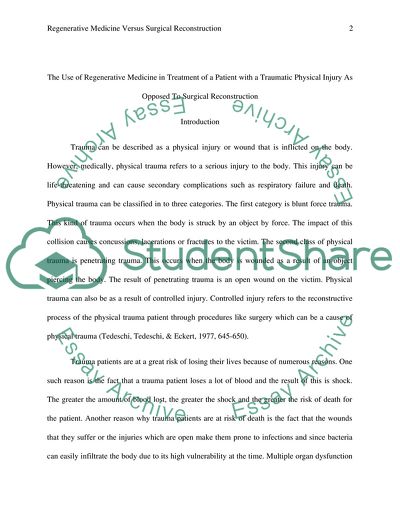Cite this document
(For a patient with a traumatic physical injury, will regenerative Research Paper - 1, n.d.)
For a patient with a traumatic physical injury, will regenerative Research Paper - 1. Retrieved from https://studentshare.org/health-sciences-medicine/1787349-for-a-patient-with-a-traumatic-physical-injury-will-regenerative-medicine-using-the-extra-cellular-matrix-technique-as-compared-to-surgical-repair-and-reconstruction-increase-patient-recovery-outcome-improve-function-and-maintain-esthetics
For a patient with a traumatic physical injury, will regenerative Research Paper - 1. Retrieved from https://studentshare.org/health-sciences-medicine/1787349-for-a-patient-with-a-traumatic-physical-injury-will-regenerative-medicine-using-the-extra-cellular-matrix-technique-as-compared-to-surgical-repair-and-reconstruction-increase-patient-recovery-outcome-improve-function-and-maintain-esthetics
(For a Patient With a Traumatic Physical Injury, Will Regenerative Research Paper - 1)
For a Patient With a Traumatic Physical Injury, Will Regenerative Research Paper - 1. https://studentshare.org/health-sciences-medicine/1787349-for-a-patient-with-a-traumatic-physical-injury-will-regenerative-medicine-using-the-extra-cellular-matrix-technique-as-compared-to-surgical-repair-and-reconstruction-increase-patient-recovery-outcome-improve-function-and-maintain-esthetics.
For a Patient With a Traumatic Physical Injury, Will Regenerative Research Paper - 1. https://studentshare.org/health-sciences-medicine/1787349-for-a-patient-with-a-traumatic-physical-injury-will-regenerative-medicine-using-the-extra-cellular-matrix-technique-as-compared-to-surgical-repair-and-reconstruction-increase-patient-recovery-outcome-improve-function-and-maintain-esthetics.
“For a Patient With a Traumatic Physical Injury, Will Regenerative Research Paper - 1”. https://studentshare.org/health-sciences-medicine/1787349-for-a-patient-with-a-traumatic-physical-injury-will-regenerative-medicine-using-the-extra-cellular-matrix-technique-as-compared-to-surgical-repair-and-reconstruction-increase-patient-recovery-outcome-improve-function-and-maintain-esthetics.


